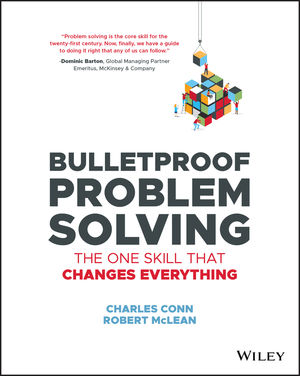Bulletproof Problem Solving
The One Skill That Changes Everything


Charles Conn is CEO of Oxford Sciences Innovation venture fund, he was a partner at McKinsey in the 1990s, and then Founding CEO of Ticketmaster-Citysearch a pioneering tech company that went public before the dot-com boom, and more recently has been CEO of the Rhodes Trust and Warden of Rhodes House at Oxford University until 2018; Robert Maclean is a Senior Adviser at McKinsey, who has led the Australian and New Zealand practice for eight years.
The World Economic Forum has identified complex problem-solving as the key skill required of organizations in the 21t century, closely followed by critical thinking and creativity. However, the authors point out, none of these are ‘taught’ in the majority of standard formal education institutions, either at high school or universities. McKinsey, the leading strategy consultancy, has been using their Seven-Step Problem-Solving method internally to deliver client solutions for decades however, but it has never been explicitly shared externally. Charles Conn drafted the original internal paper on this 7 Easy Steps to Bulletproof Problem Solving during his time there back in the early 1990’s – and is now bringing it to a wider audience.
The authors quote Herb Simon, the Economics Nobel Laureate from Carnegie Mellon, who specialized in decision-making “solving a problem simply means representing it so as to make the solution transparent” – and this, at its heart, is what this book and the 7 Steps is about. Most of the problems we are faced with today are not ones of finding a new formula to cure a disease, but for navigating our way to a sensible decision. Executing the solution is another set of challenges, but often not as complex.
The difficult part of solving-problems is not identifying the ‘what’ of the problem, but the ‘why’. At its simplest and most linear, if water is not running from your tap that is the ‘what’ of the problem, but the solution resides in why it is not flowing. Maybe the tap itself is faulty, maybe the pipe to the tap has burst, maybe there is no water flowing into the pipe. Without making the problem transparent the solution cannot be found.
The problems this book concerns itself with are more complex and systemic, but no less personal often: should I invest in solar panels? Where should I live? What career should I choose? They apply to organizational problems too: pricing, airport capacity, bus routing, market share loss. And to societal issues as well: HIV in India, reducing overfishing, can obesity be reduced?
The Seven Steps are:
1. Define the problem
2. Disaggregate it (ie broken down into component parts or issues)
3. Prioritize which of these elements has the biggest impact on the problem
4. Build a workplan
5. Conduct critical analysis (gather data)
6. Synthesize findings (this is where team work makes a difference)
7. Communicate a storyline
As a quick flip through the book shows, ‘logic trees’ (flowcharts) that map the questions, inputs and options lie at the heart of the approach – every case study is based on these.
As with so many disciplines the essential core of this is not rocket science, and can be applied by anyone to almost any problem. The issue is the discipline to follow the methodology through and the opportunity to practice it sufficiently to get adept at it. When applied to problems which are largely or partly subjective, such as ‘where should I live?’ the weightings you give to the elements are open to personal preference and bias, but these biases can also appear in more structured, quantitative problems too. The authors briefly address the bias issues. The fact that McKinsey has successfully been employing this approach for over 30 years does indicate that it works, but one wonders how proficient a user of it you need to be to factor in the more subjective elements of the tree successfully, and come up with problem-solving solutions that are not based entirely on logic to the exclusion of the relational, human aspects.
Title: Bulletproof Problem Solving: The One Skill That Changes Everything
Author/s Name/s: Charles Conn and Robert McLean
Publisher: Wiley
ISBN: 978-1-119553-02-1
Publishing Date: March, 2019
Number of Pages: 320
Author Knowledge Rating: 1-5 (based on their years of experience, academic expertise in subject areas, and exposure to cross-functional thinking in the area)









































































Readability: 1-5 score(1=dense and v academic; 5=frantic; page turner)












































































Appropriate Length: (1=could have been written in 25% of the length;5=could have been longer)












































































Core Idea Value: (1=nonsense (or entirely esoteric); 5=game-changer)











































































